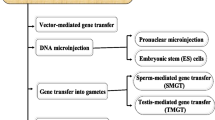Abstract
We have previously shown that, when administered orally to mice, bacteriophage M13 DNA, as a paradigm foreign DNA without homology to the mouse genome, can persist in fragmented form in the gastrointestinal tract, penetrate the intestinal wall, and reach the nuclei of leukocytes, spleen and liver cells. Similar results were obtained when a plasmid containing the gene for the green fluorescent protein (pEGFP-C1) was fed to mice. In spleen, the foreign DNA was detected in covalent linkage to DNA with a high degree of homology to mouse genes, perhaps pseudogenes, or to authentic E. coli DNA. We have now extended these studies to the offspring of mice that were fed regularly during pregnancy with a daily dose of 50 g of M13 or pEGFP-C1 DNA. Using the polymerase chain reaction (PCR) or the fluorescent in situ hybridization (FISH) method, foreign DNA, orally ingested by pregnant mice, can be discovered in various organs of fetuses and of newborn animals. The M13 DNA fragments have a length of about 830 bp. In various organs of the mouse fetus, clusters of cells contain foreign DNA as revealed by FISH. The foreign DNA is invariably located in the nuclei. We have never found all cells of the fetus to be transgenic for the foreign DNA. This distribution pattern argues for a transplacental pathway rather than for germline transmission which might be expected only after long-time feeding regimens. In rare cells of three different fetuses, whose mothers have been fed with M13 DNA during gestation, the foreign DNA was detected by FISH in association with both chromatids. Is maternally ingested foreign DNA a potential mutagen for the developing fetus?
Similar content being viewed by others
Author information
Authors and Affiliations
Additional information
Received: 15 April 1998 / Accepted: 15 June 1998
Rights and permissions
About this article
Cite this article
Schubbert, R., Hohlweg, U., Renz, D. et al. On the fate of orally ingested foreign DNA in mice: chromosomal association and placental transmission to the fetus. Mol Gen Genet 259, 569–576 (1998). https://doi.org/10.1007/s004380050850
Issue Date:
DOI: https://doi.org/10.1007/s004380050850




